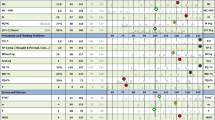Abstract
This paper presents a coding system developed to explore changes in narratives of rape during therapy for posttraumatic stress disorder (PTSD) involving repeated reliving and recounting of the trauma. Relationships between narrative categories hypothesized to be affected by the treatment and treatment outcome were also examined. As hypothesized, narrative length increased from pre- to post-treatment, percentage of actions and dialogue decreased and percentage of thoughts and feelings increased, particularly thoughts reflecting attempts to organize the trauma memory. Also as expected, increase in organized thoughts was correlated negatively with depression. While indices of fragmentation did not significantly decrease during therapy, the hypothesized correlation between decrease in fragmentation and reduction in trauma-related symptoms was detected.
Similar content being viewed by others
References
Beck, A. T., & Emery, G. (1985).Anxiety disorders and phobias: A cognitive perspective (pp. 54–66). NY: Besic Books.
Beck, A. T., Ward, C. H., Mendelsohn, M., Mock, J., & Erbaugh, J. (1961). An inventory for measuring depression.Archives of General Psychiatry, 4 561–571.
Burke, A., Heuer, F., & Reisberg, D. (1992). Remembering emotional events.Memory and Cognition, 20 277–290.
Christianson, S. (1992). Emotional stress and eyewitness memory: A critical review.Psychological Bulletin, 112 284–309.
Davidson, J. R. T., Hughes, D., Blazer, D. G., & George, L. K. (1991). Posttraumatic stress disorder in the community: An epidemiological study.Psychological Medicine, 21 713–721.
Derogatis, L. R. (1977).SCL 90: Administration, scoring, and procedures manual, I. (for the revised) Version. Towson, MD: Clinical Psychometrics Research.
Easterbrook, J. A. (1959). The effect of emotion on cue utilization and the organization of behavior.Psychological Review, 66 183–201.
Eysenck, M. W. (1982).Attention and arousal. Berlin: Springer-Verlag.
Eysenck, M. W., & Keane, M. T. (1990).Cognitive psychology: A student's handbook. London: Lawrence Erlbaum.
Foa, E. B., & Kozak, M. J. (1986). Emotional processing of fear: Exposure to corrective information.Psychological Bulletin, 99 20–35.
Foa, E. B., & Riggs, D. S. (1993). Posttraumatic stress disorder in rape victims. In J. Oldham, M. B. Riba, & A. Tasman (Eds.),American Psychiatric Press Review of Psychiatry, Volume 12 (pp. 273–303). Washington, DC: American Psychiatric Press.
Foa, E. B., Riggs,, D. S., Dancu, C. V., & Rothbaum, B. O. (1993). Reliability and validity of a brief instrument for assessing posttraumatic stress disorder.Journal of Traumatic Stress, 6 459–473.
Foa, E. B., Riggs, D. S., Massie, E. D., Yarczower, M. (in press). The impact of fear activation and anger on the efficacy of exposure treatment for PTSD.Behavior Therapy.
Foa, E. B., Rothbaum, B. O., Riggs, D., & Murdock, T. (1991). Treatment of post-traumatic stress disorder in rape victims: A comparison between cognitive-behavioral procedures and counseling.Journal of Consulting and Clinical Psychology, 59 715–723.
Harber, K. D., & Pennebaker, J. W. (1992). Overcoming traumatic memories. In S. Christianson (Ed.),The handbook of emotion and memory: Research and theory (pp. 359–387). Hillsdale, NJ: Lawrence Erlbaum Associates.
Heuer, F., & Reisberg, D. (1992). Emotion, arousal, and memory for detail. In S. Christianson (Ed.),The handbook of emotion and memory: Research and theory (pp. 151–180). Hillsdale: NJ: Lawrence Erlbaum Associates.
Horowitz, M. J., Wilner, N., & Alvarez, W. (1979). Impact of Event scale: A measure of subjective stress.Psychosomatic Medicine, 41 207–218.
Keane, T. M., Fairbank, J. A., Caddell, J. M., & Zimering, R. T. (1989). Implosive (flooding) therapy reduces symptoms of PTSD in Vietnam combat veterans.Behavior Therapy, 20 245–260.
Kilpatrick, D. G. (1988). Rape Aftermath Symptom Test. In M. Hersen & A. S. Bellack (Eds.),Dictionary of behavioral assessment techniques (366–367). Oxford: Pergamon Press.
Koss, M. P., Koss, P. G., & Woodruff, W. J. (1991). Deleterious effects of criminal victimization on women's health and medical utilization.Archives of Internal Medicine, 151 342–347.
Koss, M. P., Tromp, S., & Tharan, M. (in press). Traumatic memories: Empirical foundations, forensic and clinical implications.Clinical Psychology: Science and Practice.
Kozak, M. J., Foa, E. B., & Steketee, G. (1988). Process and outcome of exposure treatment with obsessive-compulsives: Psychophysiological indicators of emotional processing.Behavior Therapy, 19 157–169.
Kramer, T., Buckhout, R., & Eugenio, P. (1990). Weapon focus, arousal, and eyewitness memory: Attention must be paid.Law and Human Behavior, 14 167–184.
Lisak, D. (1994). The psychological impact of sexual abuse: Content analysis of interviews with male survivors.Journal of Traumatic Stress, 7 525–548.
Maass, A., & Kohnken, G. (1989). Eyewitness identification.Law and Human Behavior, 11 397–408.
Mandler, G. (1975).Mind and emotion. NY: Wiley.
Murray, E. J., Lamnin, A. D., & Carver, C. S. (1989). Emotional expression in written essays and psychotherapy.Journal of Social and Clinical Psychology, 8 414–429.
Murray, E. J., & Segal, D. L. (1994). Emotional processing in vocal and written expression of feelings about traumatic experiences.Journal of Traumatic Stress, 7 391–405.
Payne, D. G. (1987). Hypermnesia and reminiscence in recall: A historical and empirical review.Psychological Bulletin, 101 5–27.
Pennebaker, J. W., & Beall, S. K. (1986). Confronting a traumatic event: Toward an understanding of inhibition and disease.Journal of Abnormal Psychology, 95 274–281.
Pennebaker, J. W., & Kiecolt-Glaser, J., & Glaser, R. (1988). Disclosure of traumas and immune function: Health implications for psychotherapy.Journal of Consulting and Clinical Psychology, 56 239–245.
Rachman, S. (1980). Emotional processing.Behavior Research and Therapy, 18 51–60.
Roth, S., & Newman, E. (1991). The process of coping with sexual trauma.Journal of Traumatic Stress, 4 279–297.
Scrivner, E., & Safer, M. A. (1988). Eyewitnesses show hypermnesia for details about a violent event.Journal of Applied Psychology, 73 371–377.
Spielberger, C. D., Gorsuch, R. L., & Lushene, R. E. (1970).Manual for the State-Trait Anxiety Inventory (Self-Evaluation Questionnaire). Palo Alto, CA: Consulting Psychologists Press.
Spitzer, R. L., Williams, J. B. W., & Gibbon, M. (1987).Structured Clinical Interview for DSM-III-R (SCID). NY: Biometrics Research Department, New York State Psychiatric Institute.
Veronen, L. J., & Kilpatrick, D. G. (1980). Self-reported fears of rape victim.Behavior Modification, 4 383–396.
Author information
Authors and Affiliations
About this article
Cite this article
Foa, E.B., Molnar, C. & Cashman, L. Change in rape narratives during exposure therapy for posttraumatic stress disorder. J Trauma Stress 8, 675–690 (1995). https://doi.org/10.1007/BF02102894
Issue Date:
DOI: https://doi.org/10.1007/BF02102894



